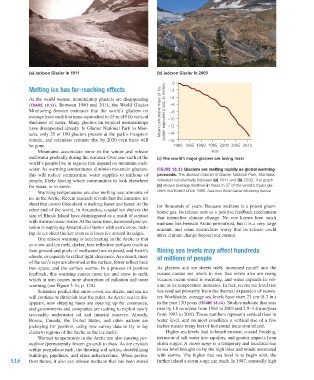Page 517 - Environment: The Science Behind the Stories
P. 517
(a) Jackson Glacier in 1911 (b) Jackson Glacier in 2009
0
Melting ice has far-reaching effects –2
As the world warms, mountaintop glaciers are disappearing –4
(Figure 18.13). Between 1980 and 2011, the World Glacier –6
Monitoring Service estimates that the world’s glaciers on Mean cumulative mass of ice (water equivalent) lost, in meters –8
average have each lost mass equivalent to 15 m (49 ft) vertical –10
thickness of water. Many glaciers on tropical mountaintops
have disappeared already. In Glacier National Park in Mon- –12
tana, only 25 of 150 glaciers present at the park’s inception –14
remain, and scientists estimate that by 2030 even these will –16
be gone. 1980 1985 1990 1995 2000 2005 2010
Mountains accumulate snow in the winter and release Year
meltwater gradually during the summer. Over one-sixth of the (c) The world’s major glaciers are losing mass
world’s people live in regions that depend on mountain melt-
water. As warming temperatures diminish mountain glaciers, Figure 18.13 Glaciers are melting rapidly as global warming
this will reduce summertime water supplies to millions of proceeds. The Jackson Glacier in Glacier National Park, Montana,
people, likely forcing whole communities to look elsewhere retreated substantially between (a) 1911 and (b) 2009. The graph
for water, or to move. (c) shows average declines in mass in 37 of the world’s major gla-
Warming temperatures are also melting vast amounts of ciers monitored since 1980. Data from World Glacier Monitoring Service.
ice in the Arctic. Recent research reveals that the immense ice
sheet that covers Greenland is melting faster and faster. At the for thousands of years. Because methane is a potent green-
other end of the world, in Antarctica, coastal ice shelves the house gas, its release acts as a positive feedback mechanism
size of Rhode Island have disintegrated as a result of contact that intensifies climate change. No one knows how much
with warmer ocean water. At the same time, increased precipi- methane lies beneath Arctic permafrost, but it is a very large
tation is supplying Antarctica’s interior with extra snow, mak- amount, and some researchers worry that its release could
ing its ice sheet thicker even as it loses ice around its edges. drive climate change beyond our control.
One reason warming is accelerating in the Arctic is that
as snow and ice melt, darker, less reflective surfaces (such as
bare ground and pools of meltwater) are exposed, and Earth’s Rising sea levels may affect hundreds
albedo, or capacity to reflect light, decreases. As a result, more of millions of people
of the sun’s rays are absorbed at the surface, fewer reflect back
into space, and the surface warms. In a process of positive As glaciers and ice sheets melt, increased runoff into the
feedback, this warming causes more ice and snow to melt, oceans causes sea levels to rise. Sea levels also are rising
which in turn causes more absorption of radiation and more because ocean water is warming, and water expands in vol-
warming (see Figure 5.1b, p. 124). ume as its temperature increases. In fact, recent sea level rise
Scientists predict that snow cover, ice sheets, and sea ice has resulted primarily from the thermal expansion of seawa-
will continue to diminish near the poles. As Arctic sea ice dis- ter. Worldwide, average sea levels have risen 21 cm (8.3 in.)
appears, new shipping lanes are opening up for commerce, in the past 130 years (Figure 18.14). Studies indicate that seas
and governments and companies are rushing to exploit newly rose by 1.8 mm/year from 1961 to 2003 and 2.9–3.4 mm/year
accessible underwater oil and mineral reserves. Already, from 1993 to 2010. These numbers represent vertical rises in
Russia, Canada, the United States, and other nations are water level, and on most coastlines a vertical rise of a few
jockeying for position, using new survey data to try to lay inches means many feet of horizontal incursion inland.
claim to regions of the Arctic as the ice melts. Higher sea levels lead to beach erosion, coastal flooding,
Warmer temperatures in the Arctic are also causing per- intrusion of salt water into aquifers, and greater impacts from
mafrost (permanently frozen ground) to thaw. As ice crystals storm surges. A storm surge is a temporary and localized rise
within permafrost melt, the thawing soil settles, destabilizing in sea level brought on by the high tides and winds associated
buildings, pipelines, and other infrastructure. When perma- with storms. The higher that sea level is to begin with, the
516 frost thaws, it also can release methane that has been stored further inland a storm surge can reach. In 1987, unusually high
M18_WITH7428_05_SE_C18.indd 516 12/12/14 4:05 PM

